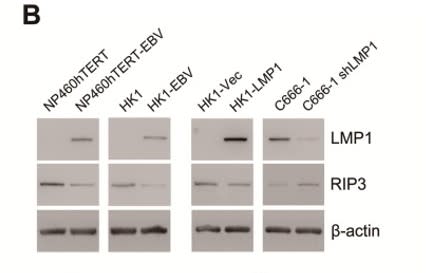Cat. #151471
Anti-EBV Latent Membrane Protein 1 [CS 1-4]
Cat. #: 151471
Sub-type: Primary antibody
Unit size: 100 ug
Availability: 3-4 weeks
Target: Epstein-Barr Virus, Latent Membrane Protein 1 (EBV-LMP1)
Class: Monoclonal
Application: IHC ; IHC ; IF ; IP ; WB
Reactivity: Virus
Host: Mouse
£300.00
This fee is applicable only for non-profit organisations. If you are a for-profit organisation or a researcher working on commercially-sponsored academic research, you will need to contact our licensing team for a commercial use license.
Contributor
Inventor: Martin Rowe
Institute: University of Birmingham
Tool Details
*FOR RESEARCH USE ONLY (for other uses, please contact the licensing team)
- Name: Anti-EBV Latent Membrane Protein 1 [CS 1-4]
- Research fields: Cancer;Cell biology;Cell signaling and signal transduction;Immunology;Microbiology
- Clone: CS 1-4
- Tool sub type: Primary antibody
- Class: Monoclonal
- Conjugation: Unconjugated
- Molecular weight: 57-66 kDa
- Reactivity: Virus
- Host: Mouse
- Application: IHC ; IHC ; IF ; IP ; WB
- Description: Anti-EBV (CS1) is a latent membrane protein 1 antibody, which detects a specific epitope upon LMP fusion protein in B-cell transformations, following EBV infection.
- Immunogen: P03230
- Immunogen uniprot id: P03230
- Isotype: IgG1 kappa
- Myeloma used: P3X63Ag8.653
- Recommended controls: EBV transformed lymphoblastoid cell lines
Target Details
- Target: Epstein-Barr Virus, Latent Membrane Protein 1 (EBV-LMP1)
- Molecular weight: 57-66 kDa
- Tissue cell line specificity: EBV transformed lymphoblastoid cell lines
- Target background: A combination of four pooled antibodies which collectively detect the latent membrane protein (LMP) of EBV, an important effector protein in B-cell transformation under EBV infection, across 20 geographically distinct EBV isolates. EBV is a human herpesvirus that establishes a life-long persistence in the host. The virus infects the vast majority of the world's adult population and is well known for its association with a broad spectrum of benign and malignant diseases. These include infectious mononucleosis, Burkitt's lymphoma, nasopharyngeal carcinoma, and is causally associated with lymphoid and epithelial malignancies, including post-transplant lymphoproliferative disorders, Hodgkin's disease, anaplastic nasopharyngeal carcinoma and gastric carcinomas. Latent membrane protein 1 (LMP1) of Epstein-Barr virus (EBV) is a transforming protein that affects multiple cell signalling pathways and contributes to EBV-associated oncogenesis. LMP1 can be expressed in some states of EBV latency, and significant induction of full-length LMP1 is also observed frequently during virus reactivation into the lytic cycle. LMP1 is critical for EBV-infected cell activation, adhesion and survival, and is usually expressed in the malignant cells. These antibodies were created to examine various aspects of LMP expression in B-cell lines transformed in vitro, detecting LMPs from 20 geographically varied EBV isolates.
Applications
- Application: IHC ; IHC ; IF ; IP ; WB
Handling
- Format: Liquid
- Concentration: 1 mg/ml
- Unit size: 100 ug
- Storage buffer: PBS with 0.02% azide
- Storage conditions: Store at -20° C frozen. Avoid repeated freeze / thaw cycles
- Shipping conditions: Dry ice
Related Tools
- Related tools: Anti-EBV Latent Membrane Protein 1 [LMPO24]
References
- Ye et al. 2020. J Cancer. 11(5):1257-1269. PMID: 31956372.
- Shi et al. 2019. Theranostics. 9(9):2424-2438. PMID: 31131045.
- Wang et al. 2017. Virol Sin. 32(5):423-430. PMID: 29116594.
- Martin et al. 2016. J Virol. 90(19):8520-30. PMID: 27440880.
- Castrale et al. 2011. J Transplant. 2011:865957. PMID: 21559262.
- Flanagan et al. 2003. J Gen Virol. 84(Pt 7):1871-9. PMID: 12810882.
- Localization of the Epstein-Barr virus protein LMP 1 to exosomes.
- Nakatsuka et al. 2002. J Clin Oncol. 20(20):4255-60. PMID: 12377970.
- Pyothorax-associated lymphoma: a review of 106 cases.
- Xu et al. 2002. J Virol. 76(8):4080-6. PMID: 11907247.
- Preferential localization of the Epstein-Barr virus (EBV) oncoprotein LMP-1 to nuclei in human T cells: implications for its role in the development of EBV genome-positive T-cell lymphomas.
- Ascani et al. 1997. Ann Oncol. 8(11):1133-8. PMID: 9426333.
- Pyothorax-associated lymphoma: description of the first two cases detected in Italy.
- Epstein-Barr virus (EBV)-associated lymphoproliferative disease in the SCID mouse model: implications for the pathogenesis of EBV-positive lymphomas in man.
- Rowe et al. 1991. J Exp Med. 173(1):147-58. PMID: 1845872.
- Rowe et al. 1987. J Gen Virol. 68 ( Pt 6):1575-86. PMID: 2438376.
- Monoclonal antibodies to the latent membrane protein of Epstein-Barr virus reveal heterogeneity of the protein and inducible expression in virus-transformed cells.


![Anti-EBV Latent Membrane Protein 1 [CS 1-4] - Image 2](https://cancertools.org/wp-content/uploads/d302965a-ef6c-46f3-b44b-11e0ae848b38.jpg)
![Anti-EBV Latent Membrane Protein 1 [CS 1-4] - Image 3](https://cancertools.org/wp-content/uploads/fb6a365f-e24a-440c-a498-721c7a8bfc02.jpg)



